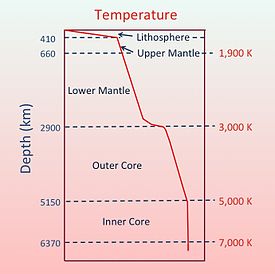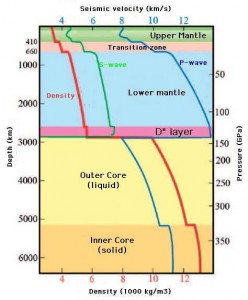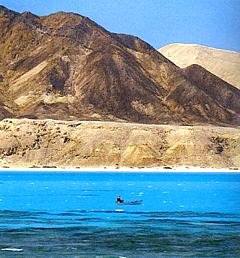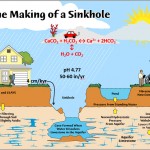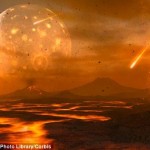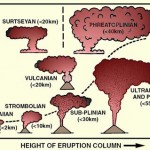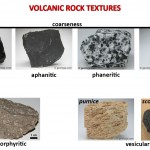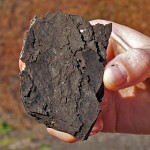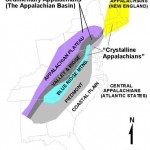Here is an easy chart gathering together basic facts about each of the earth's layers, from top to bottom: the crust, the mantle, and the core. The crust and uppermost part of the mantle (down to 70 km) from the rigid lithosphere, which contains tectonic plates, underneath which lies the fluid taffy-like asthenosphere, which drives plate motion. Unsurprisingly, as you travel deeper into the earth, things get denser, hotter, and and more pressurized.
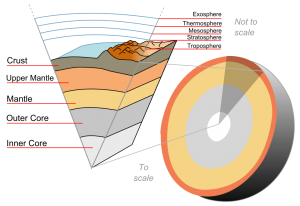 In terms of volume and mass, the mantle is the biggest layer and the crust is the smallest. The crust takes 1% of earth's volume and 0.5% of earth's mass; the mantle commands 84% of earth's volume and 68% of earth's mass; finally, the core has 15% of earth's volume, but due to its great density, holds a disproportionate amount of earth's mass—31.5%.
In terms of volume and mass, the mantle is the biggest layer and the crust is the smallest. The crust takes 1% of earth's volume and 0.5% of earth's mass; the mantle commands 84% of earth's volume and 68% of earth's mass; finally, the core has 15% of earth's volume, but due to its great density, holds a disproportionate amount of earth's mass—31.5%.
| Depth[1] / Thickness (km) | Temperature[2] (K) | Pressure[3] (GPa) =104 atm | Density[1] (g/cm3) | Composition[1] | |
| Crust | 0 / 70 | 0-500 | 0-20 | 2.2-2.9 | granite (feldspar, quartz), basalt |
| Upper Mantle | 70 / 590 | 500-1900 | 20-40 | 3.4-4.4 | peridotites (olivine, pyroxene, garnet) |
| Lower Mantle | 660 / 2150 | 1900-4000 | 40-140 | 4.4-5.6 | perovskite (magnesium, silicon oxides) |
| Outer Core | 2900 / 2250 | 4000-6000 | 140-330 | 9.9-12.1 | liquid iron oxides, sulfur, nickel alloy |
| Inner Core | 5150 / 1220 | 6000-7000 | 330-360 | 12.8-13.1 | solid iron oxides, sulfur, nickel alloy |
| Total | 6370 |
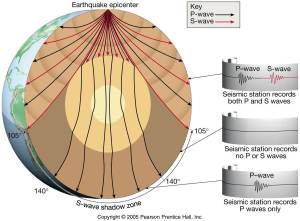 Scientists are able to "view" the interior of the earth by observing (with seismometers) seismic body waves that bounce back: S-waves and P-waves. The wave velocity changes with the density of the medium it is traveling through; an abrupt change in velocity helps mark a layer boundary. Additionally, since S-waves and P-waves travel at different speeds (see this animation), one can locate earthquake epicenters based on differential wave arrival times. S-waves are slower (in rock) and cannot travel through liquid (one clue that the outer core is liquid). Think S-waves: slow and solid. Fun fact: the liquid core, which spins around the solid core, completes one lap every 1,200-1,8000 years.
Scientists are able to "view" the interior of the earth by observing (with seismometers) seismic body waves that bounce back: S-waves and P-waves. The wave velocity changes with the density of the medium it is traveling through; an abrupt change in velocity helps mark a layer boundary. Additionally, since S-waves and P-waves travel at different speeds (see this animation), one can locate earthquake epicenters based on differential wave arrival times. S-waves are slower (in rock) and cannot travel through liquid (one clue that the outer core is liquid). Think S-waves: slow and solid. Fun fact: the liquid core, which spins around the solid core, completes one lap every 1,200-1,8000 years.
Pressure and temperature are calculated based on mathematical relationships with depth. Layer composition is determined by direct observation. We can directly observe many rocks that compose the crust, and we can also view mantle rocks through xenoliths and ophiolites. Several islands near Egypt, such as St. John's, were formed when parts of the mantle were thrown up (check out some photos)! The makeup of the core, however, must be inferred, using data such as its density, its magnetic properties (which strongly implies iron content), the mineralogy of meteorites, and calculations about what type of materials would exist under its high pressures and temperatures.
Earth Stats
- Earth's mass: 5.97 x 1024 kg
- Earth's radius: 6,371 km
- Earth's diameter: 12,742 km
- Distance to moon: 384,400 km
- Distance to sun: 149,600,000 km (1 AU)

